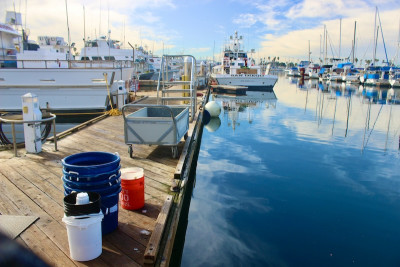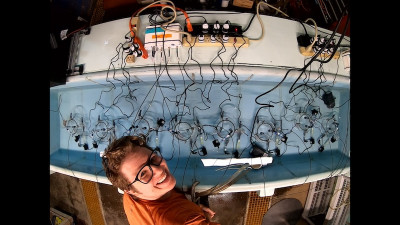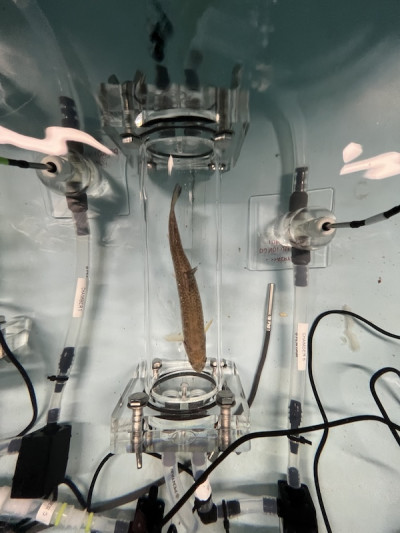This is the eleventh in a yearlong series of stories showcasing the research that the Ocean Protection Council supported in partnership with California Sea Grant, with funding from Proposition 84.
Since the late 2000s, scientists have observed that many of the world’s fish species are getting smaller in terms of average adult body size. Thiephenomenon appears to be tied to the warming of the oceans. Because smaller body sizes can cause lower population biomass and reproductive output, this trend has potentially serious implications for how much fish can be harvested, impacting economies and food security.
One proposed mechanism that could explain this trend is “Gill Oxygen Limitation,” or GOL. The GOL hypothesis suggests that gills, as the source of a fish’s oxygen, may be a limiting factor in their growth. Although the hypothesis has already been used in some projections of future fisheries yields, it has not yet been directly tested empirically, in targeted studies with living fish.
That’s why a team of scientists at the University of Massachusetts, Amherst, the Southwest Fisheries Science Center at the National Ocean and Atmospheric Administration and the University of California, Davis, set out to collect the needed data, using funding from the Ocean Protection Council. After weathering unexpected obstacles presented by COVID and climate change, the team’s results suggest that we might need to rethink the hypothesis.
The sardine workaround
The GOL hypothesis rests on a seemingly intuitive idea: Animals require oxygen to produce energy, so if there is a limit on their oxygen supply, that could put a damper on growth. Since it’s through gills that fish pull oxygen out of the water, the size of gills may matter.

Gills are made up of complex folds of tissue, and there’s only so much room inside a fish for such structures. As a fish grows bigger, the gills will get bigger, too, but maybe not fast enough to keep up with the increased energy demands of being a bigger fish. The GOL hypothesis suggests there’s a “mismatch” between how much oxygen a fish needs as it grows larger and how much the gills can supply. In warmer conditions, biological processes speed up, demanding more energy — which could turn that mismatch into a limit on how big a fish can grow in the warming world.
The evidence typically used to support this hypothesis stems from studies that focused on other questions. It’s a difficult question to answer, after all: Many economically important fish grow slowly, so a proper study could take years. But the research team found a way around that problem: They chose to study Pacific sardines, an economically and culturally important species that, despite its long lifespan, reaches maturity in less than two years. The team planned to measure growth, gill surface area and the energetic demands sardines face — variables that have been measured in other studies, but never in concert for a single species.
Sardines, though, present their own challenges: Small, pelagic fish cannot be studied in standard laboratory setups. Tanks with right-angled edges are out of the question since schooling fish aren’t used to boundaries. Sardines can also die from the stress of isolation, which made the respirometer trials used to establish energetic demands difficult. “How many ‘friends’ does a sardine need to stay calm and stress-free? That was the first test we had to run,” says Lisa Komoroske, an assistant professor of environmental conservation at the UMass-Amherst who helped lead the project.
Once that fact was established — five fish, it turned out — post-doctoral researcher Joshua Lonthair placed tiny tags on the 1,600 sardines that would be used in the growth experiment. “Then COVID happened,” he says. Access to the laboratory, at the NOAA Southwest Fisheries Science Center in La Jolla, became restricted. Just weeks later, a harmful algal bloom called a red tide hit the California coast, drastically altering water quality along the shore and causing massive fish kills both in the wild and in laboratories fed with local ocean water.
“So that ended the long-term experiment,” Lonthair says.
Making red-tide lemonade
The team still managed to gather important information on what kind of environmental conditions Pacific sardines can tolerate. Some scientists had assumed that these fish were highly sensitive to low levels of oxygen in the surrounding water, a condition called hypoxia. But Lonthair found the fish could tolerate oxygen concentrations below 20% — “way below levels seen in most ecological conditions,” Lonthair says.

Pacific sardine populations have crashed several times over the past century, and the fishery has been closed since 2015. People have offered many ideas as to why sardine populations are fragile, most of which focus on environmental factors that impact spawning and recruitment. “But these fish, according to our data, are more tolerant of both temperature and hypoxic conditions than we expected.” Komoroske notes that the species’ tolerance for such conditions is different than its preference, which means warmer and hypoxic oceans will still impact sardines’ range. Still, the results show that fisheries managers need more information. “You need really solid physiological evidence and metrics to get the bigger picture of how distributions change and global climate processes impact fisheries,” Lonthair says.
When the red tide hit, Lonthair was collecting data on the effects of temperature. That made for an unexpected twist to the study: “We got to see the impacts of a multi-stressor event,” he says. Although warm water, at 19.5°C (67°F) had not impacted sardine survival on its own, the fish that had been exposed to that heat wound up dying at higher rates from the algal bloom than the fish living in cooler conditions. “So sardines appear fairly resilient in the face of hypoxia or increased temperature alone,” Lonthair says. “But put them together, or combine them with another stressor, and the effects can be very different.” These results, along with changes in gill morphology during the red tide, were recently published in the journal Elementa: Science of the Anthropocene.
New coast, new fish

As useful as the data was, the red tide meant that Lonthair had no results that could speak to the validity of the GOL hypothesis. That would have required longer growout experiments. Fortunately, Komoroske realized that a U.S Geological Survey fish laboratory affiliated with her university in Massachusetts did extensive work on brook trout. At first blush that may sound like a far too different fish: The research team was replacing a Pacific marine species with a freshwater species native to the U.S. Northeast. “But this hypothesis that we’re testing is supposed to be global,” Lonthair explains. “It should apply to any species.” Indeed, Komoroske and Lonthair realized that brook trout might be preferable since they’re faster-growing. Brook trout reach maturity — increasing a hundredfold in size — in less than a year. And they are more amenable to laboratory studies: As Lonthair notes, unlike sardines, “brook trout don’t need friends.”
To test the GOL hypothesis, Lonthair and Komoroske tracked the same individual fish over time, examining both the size of their gills and their energetic needs. Both attributes should increase as the fish grows larger — but the GOL hypothesis suggests that the changes in a fish’s energetic needs outpace the changes in its gill size. They exposed the brook trout to two different temperature conditions, 15° and 20°C (59° and 68°F). As expected, after an eight-month growout period, the fish in warmer water were smaller — their body mass increased, on average, 30-fold, compared to 77-fold for the fish in cooler conditions.
But when they measured the fish’s metabolic rates, they found that it did not increase any faster than its gill size, and in most cases increased more slowly. So, at least for brook trout, “it’s not the gills that are causing reduced fish size,” Lonthair says. He and his colleagues have written up their results in another paper, published in the Journal of Experimental Biology in February, and the research was featured in the Washington Post. There are alternative hypotheses, they note, and given the stakes as the climate warms, there is an “urgent need” to examine these so we can have a clearer picture of the future of the world’s fish.